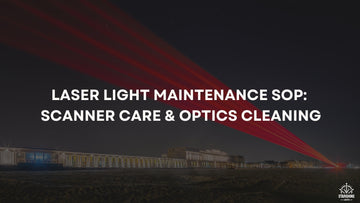
- Simple cadence, fewer surprises: weekly/monthly/quarterly routines keep scanners smooth and optics crisp.
- Clean smart, not hard: non-contact first; straight pulls with ≥99% IPA; no circular scrubbing—ever.
- Heat management decides lifespan: clear vents, confirm fan curves, avoid long high-KPPS abuse.
- Carry the right spares: galvo+driver pair, fans, front glass, PSU, interlock kit—labelled and bagged.

Weekly / Monthly / Quarterly Maintenance Checklist
- Exterior & safety: quick look at housing, yokes, connectors, interlocks, and E-Stop loop; do a short functional test.
- Air path: check fan intakes/outlets; vacuum gently; confirm normal spin-up and no odd noises.
- Front element: start non-contact (hand blower). Only clean if you actually see film (see Optics Cleaning).
- Quick geometry: run ILDA squares/circles/45° lines; note overshoot/undershoot and corner stability.
- Log it: unit ID, ambient temp, hours, actions. Drop a photo if you fixed anything.
- Optics: remove haze film on front glass/mirrors with the approved method and solvent.
- Galvo health: listen at 0/50/100% park for bearing/driver whine; check diagonals for jitter.
- Thermals: clean heat sinks/ducts; confirm airflow. Reapply TIM only if the service manual allows.
- Electrical: meter PSU rails under load, confirm ground continuity/strain relief; capture firmware versions.
- Docs: update known issues; note parts usage; set the next service date.
- Full geometry & speed: ILDA 12K/30K frames, settle times, corner sharpness vs baseline.
- Connections: re-seat ribbon/data cables; inspect mounts for creep or heat-related drift.
- Environmentals: replace filters/gaskets by venue type (desert/coastal/indoor club).
- Alignment: re-center mirror/aperture if drift exceeds tolerance; save baseline photos.
- Ops enablement: refresh QR cards and laminated SOPs inside roadcases.
| Interval | Focus | Typical Time |
|---|---|---|
| Weekly | Safety checks, air path, ILDA quick geometry | 10–15 min / unit |
| Monthly | Optics cleaning, thermals, PSU rails, firmware capture | 20–30 min / unit |
| Quarterly | Full geometry, alignment, filters/gaskets, documentation | 30–45 min / unit |

Optics Cleaning: Do’s & Don’ts
- Go non-contact first: hand-squeezed blower → anti-static brush → lens tissue.
- Use high-purity isopropyl (≥99%) or approved optical cleaner; new tissue every pass.
- Straight pulls with minimal pressure; support the optic; edge-to-center to avoid pooling.
- Cap optics during rigging; stash silica packs in roadcases (essential for laser projector outdoor work).
- No canned air up close (propellant spatter risk).
- No circular scrubbing (micro-swirls scatter beams).
- No ammonia/household glass cleaners (they attack coatings).
- No shared cloths between coated mirrors and flat glass.

Scanner Care: Thermal Management & Lifespan

Failure Cases & Spares Matrix
| Symptom | Likely Cause | Field Fix (SOP) |
|---|---|---|
| Dim / ghosted aerials | Haze film on front glass or mirror | Non-contact clean → straight pulls with ≥99% IPA → exposure recheck |
| Diagonal jitter / wobble | Galvo bearing wear or driver trim drift | Swap galvo+driver pair; re-tune per service doc; run ILDA frames |
| Thermal throttling | Blocked fins / failed fan / aged TIM | Clean fins; replace fan; re-paste only if manual allows |
| Random output dropout | PSU sag / loose DC connector | Meter under load; re-seat and tie-down; replace PSU if rails drift |
- Critical: galvo + driver pair, front glass, fans, PSU, interlock keys, E-Stop, labelled cable set.
- Consumables: gaskets, filters, silica packs, lens tissues, approved solvents.
- Docs & packaging: QR mini-guides, RMA sheets, resealable bags by part number.
- Maintenance log: unit ID, date, ambient, hours, geometry notes, photos, technician—logs tie to warranty/SLA.
- Safety & labels: confirm interlock labels, serials, class tags, and power ratings—especially before shipping a professional outdoor laser light projector across borders.
- Prep checklists: laminate weekly/monthly/quarterly pages; keep a printed laser light maintenance card in every roadcase.
Coastal Arena Residency. Monthly optics pulls + fan-path cleaning cut aerial haze buildup by ~70%; scanners ran 4–6 °C cooler, keeping tight graphics camera-safe.
Desert Festival Fleet. Filter swaps every two shows + dust caps during rigging prevented three expected driver swaps; stage laser lights ran six weekends with zero scanner failures.
Prime-Time TV (Fast Turn). Pre-labelled spares (galvo/driver/PSU) and QR mini-guides enabled a 9-minute driver swap in rehearsal; no retakes on show night.
What’s the safest way to clean optics on tour?
Blower → anti-static brush → fresh lens tissue with ≥99% IPA in straight pulls. Avoid circular scrubbing and household glass cleaners to protect coatings.
How often should scanners be serviced?
Weekly checks for geometry/noise, monthly shop time, and quarterly deep-dives. Dusty or coastal venues may need more frequent filter and vent care.
Which spare parts should every case carry?
Galvo + driver pair, front glass, fans, PSU, interlock keys, E-Stop, and a labelled cable set—plus approved wipes/solvent per your optics cleaning SOP.
When do we ship units to the factory/manufacturer?
When coatings are damaged, thermal faults repeat, rails drift under load, or board-level work is suspected. Starshine provides RMA and advance replacements for bulk fleets.
Can Starshine provide customization or OEM/ODM service labels?
Yes—custom faceplates, branded QR guides, and service labels. We can include factory burn-in reports tied to your serial list.
Does aggressive programming reduce scanner life?
Sustained high-amplitude, high-KPPS effects can. Balance cue design with short rest windows and realistic vector counts to extend life.



























